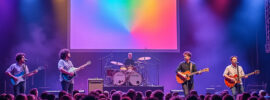The FIFA Club World Cup 2025 final at MetLife Stadium in New Jersey was a historic moment for soccer and music fans alike, as it marked the first-ever halftime show in the tournament’s history. Headlined by global superstars J Balvin, Doja Cat, Tems, and Emmanuel Kelly, with a surprise performance by Coldplay, the 15-minute spectacle brought a Super Bowl-style energy to the Chelsea vs. Paris Saint-Germain matchup. This groundbreaking event, curated by Coldplay’s Chris Martin in partnership with Global Citizen, not only electrified the crowd but also supported a meaningful cause—raising funds for global education. Here’s a deep dive into this unforgettable performance and why it’s a game-changer for FIFA events.

A Star-Studded Lineup Lights Up MetLife Stadium
The halftime show, held on July 13, 2025, was a vibrant celebration of global music and unity. The lineup featured:
- J Balvin: The Colombian reggaeton icon kicked off the show with his high-energy hits “Mi Gente” and “Reggaeton,” joined by dancers and drummers, setting an electrifying tone.
- Tems: Representing Africa, the Nigerian Grammy winner delivered a soulful performance of “Love Me JeJe,” blending Afrobeat textures with powerful vocals.
- Doja Cat: The North American superstar brought fierce choreography and genre-bending flair with her hit “Woman,” captivating the audience with her dynamic stage presence.
- Emmanuel Kelly: The Australian singer, the first differently-abled pop artist to perform at a FIFA halftime show, joined Coldplay for a heartfelt rendition of “A Sky Full of Stars,” closing the set with a message of inclusion.
- Coldplay: In a surprise appearance, the British rock band, led by Chris Martin, joined Emmanuel Kelly for an uplifting finale, with all performers uniting on stage.
This diverse lineup, representing South America, Africa, North America, and Australia, showcased FIFA’s commitment to cultural inclusivity and global unity through music and sport.
A High-Tech Stage Designed for Impact
Unlike traditional halftime shows, the FIFA Club World Cup performance took place on an innovative stage built in the upper stands of MetLife Stadium. Designed by Global Citizen and curated by Chris Martin, the 40,000-pound stage, complete with LED displays and 16 million pixels, was strategically placed to preserve the newly installed grass pitch. This setup ensured a seamless transition between the game’s halves while delivering a visually stunning spectacle. The stage, transported by six semi-trucks and assembled by 100 stagehands, was a testament to the event’s ambition to merge sport and entertainment on a grand scale.
A Performance with Purpose
Beyond the music, the halftime show supported the FIFA Global Citizen Education Fund, aiming to raise $100 million for global education access. One dollar from each ticket sold was donated to the cause, aligning the event with a mission to empower children worldwide through quality education. Doja Cat expressed her pride in representing America while supporting this initiative, stating, “I’m grateful to continue to support global education efforts by raising funds for the FIFA Global Citizen Education Fund.” Emmanuel Kelly echoed this sentiment, emphasizing the importance of inclusion: “To be part of the first-ever FIFA Club World Cup Final Halftime Show is a dream come true, not just for me, but for every differently-abled child who has ever thought their dreams were out of reach.”
Why This Halftime Show Matters
The FIFA Club World Cup 2025 halftime show was a groundbreaking moment for several reasons:
- Historic First: This was FIFA’s first-ever halftime show during a tournament, setting a precedent for future events, including the 2026 FIFA World Cup, which will also feature performances curated by Chris Martin
- Cultural Diversity: The lineup’s global representation highlighted soccer’s universal appeal, bringing together artists from different continents and genres.
- Inclusivity Milestone: Emmanuel Kelly’s participation as the first differently-abled pop artist to perform at a FIFA event was a powerful step toward breaking barriers and promoting visibility for differently-abled individuals.
- Blending Sport and Music: By adopting a Super Bowl-style halftime show, FIFA aimed to attract a broader audience, merging the excitement of soccer with high-energy musical performances.
Fan and Critic Reactions
The halftime show sparked a range of reactions on social media. Some fans praised the vibrant performances and the message of unity, with one X post calling it “Música global para una final inolvidable” (global music for an unforgettable final). Others, however, felt the diverse lineup was “messy,” suggesting a single headliner might have been more cohesive. Despite mixed sentiments, the show’s historic nature and its charitable impact were widely celebrated.
What’s Next for FIFA and Halftime Shows?
FIFA’s bold move to introduce a halftime show signals a new era for soccer entertainment. With Chris Martin already working on curating performances for the 2026 FIFA World Cup, fans can expect even bigger spectacles in the future. The success of the 2025 Club World Cup halftime show, coupled with its innovative stage design and charitable focus, sets a high bar for blending sport, music, and social good.
Conclusion
The FIFA Club World Cup 2025 halftime show, featuring Coldplay’s surprise performance alongside J Balvin, Doja Cat, Tems, and Emmanuel Kelly, was a landmark moment in soccer history. This vibrant, inclusive, and purpose-driven spectacle not only entertained a global audience but also raised awareness for education access and inclusivity. As FIFA continues to innovate, this halftime show will be remembered as a defining step toward uniting the worlds of sport and music. For more updates on FIFA events and global music performances, stay tuned to CapitalCityTickets.com.



